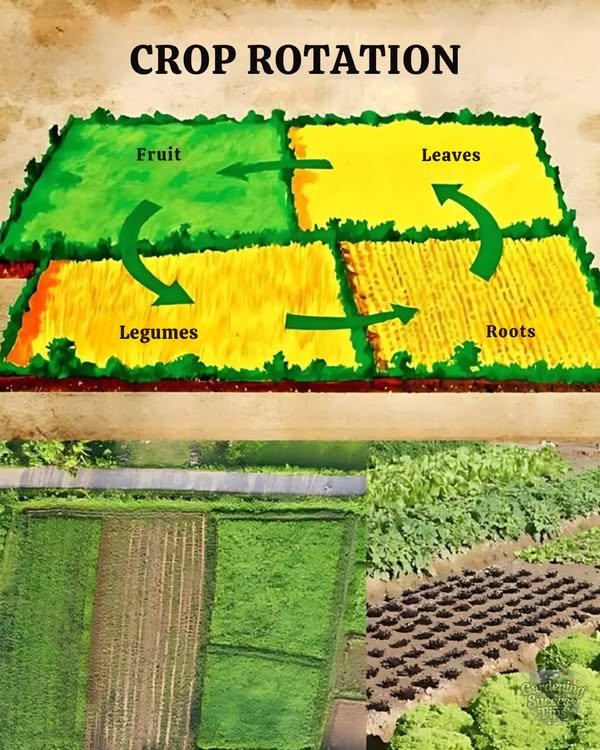Crop rotation is one of the **oldest and most effective farming techniques**, yet many gardeners and farmers still overlook its full potential. By strategically **alternating different plant families in the same soil over multiple growing seasons**, you can **restore nutrients, reduce pests, and improve soil health**—leading to bigger, healthier harvests.
Whether you’re a backyard gardener or a large-scale farmer, **crop rotation is a game-changer** for sustainable agriculture. In this guide, we’ll explore **how crop rotation works, its benefits, and how you can easily implement it to maximize your yield** 🚜🌿
## **🔄 What is Crop Rotation?**

Crop rotation is the practice of **growing different types of crops in the same area across different seasons** to maintain soil fertility and health. Instead of planting the same crop in the same spot year after year (which depletes nutrients and attracts pests), rotation **balances soil composition and naturally breaks pest cycles**.
For example, if you plant nitrogen-hungry crops like tomatoes in one season, you can rotate with nitrogen-fixing plants like beans the next season to **restore** the soil. This simple method can **prevent soil degradation and improve productivity** without relying on synthetic fertilizers.
## **🌾 How Crop Rotation Works – The 4 Main Crop Groups**
To get the most benefits from crop rotation, crops are divided into **four main categories** based on their impact on the soil:
### **1️⃣ Fruit-Producing Plants (Heavy Feeders)**
These crops **consume a lot of nutrients** from the soil and require **rich, well-fertilized ground**.
🔹 Examples: **Tomatoes, Peppers, Eggplants, Cucumbers, Squash, Pumpkins**
💡 **Rotation Tip:** Grow legumes before these crops to restore nitrogen.
### **2️⃣ Leafy Greens (Moderate Feeders)**
These plants use a **moderate** amount of nutrients but benefit from nitrogen-rich soil.
🔹 Examples: **Lettuce, Spinach, Kale, Cabbage, Swiss Chard**
💡 **Rotation Tip:** Follow nitrogen-fixing plants like legumes to take advantage of replenished nutrients.
### **3️⃣ Root Vegetables (Soil Aerators)**
These crops grow underground, helping **loosen and aerate the soil**, which improves drainage.
🔹 Examples: **Carrots, Beets, Radishes, Potatoes, Onions, Garlic**
💡 **Rotation Tip:** Follow leafy greens to make use of remaining nutrients.
### **4️⃣ Legumes (Nitrogen Fixers)**
Legumes have the ability to **pull nitrogen from the air and store it in the soil**, improving fertility.
🔹 Examples: **Beans, Peas, Lentils, Chickpeas, Clover**
💡 **Rotation Tip:** Plant legumes before heavy feeders to naturally fertilize the soil.
By rotating these crop groups in a cycle, you can **keep the soil balanced and full of nutrients** year after year.
## **💡 The Benefits of Crop Rotation**

### ✅ **1. Prevents Nutrient Depletion**
Different plants absorb and contribute different nutrients to the soil. By rotating crops, you **maintain a natural balance** and reduce the need for synthetic fertilizers.
### ✅ **2. Reduces Pests & Diseases**
Many pests and diseases are **specific to certain plant families**. If you plant the same crop in the same spot every year, pests will multiply. Rotation disrupts pest cycles, reducing infestations naturally.
### ✅ **3. Improves Soil Structure & Fertility**
– Root vegetables break up compacted soil.
– Legumes **fix nitrogen**, enriching the soil for future plants.
– Leafy greens and fruits take advantage of replenished nutrients.
### ✅ **4. Controls Weeds Naturally**
Rotating crops prevents certain weeds from dominating your garden, as different plants compete with weeds in unique ways.
### ✅ **5. Increases Crop Yield & Quality**
Healthier soil means **stronger plants** and **better harvests** without excessive fertilizers or pesticides.
## **📆 Example of a 4-Year Crop Rotation Plan**
Here’s a simple **4-year rotation plan** that you can apply to your garden or farm:
### **🌱 Year 1: Legumes (Nitrogen Fixers)**
– **Plant:** Beans, peas, or lentils.
– **Benefit:** Increases soil nitrogen for next crops.
### **🌿 Year 2: Leafy Greens (Moderate Feeders)**
– **Plant:** Lettuce, spinach, kale, cabbage.
– **Benefit:** Uses available nitrogen and prevents soil erosion.
### **🍅 Year 3: Fruits (Heavy Feeders)**
– **Plant:** Tomatoes, peppers, squash, cucumbers.
– **Benefit:** Uses remaining nutrients while growing strong crops.
### **🥕 Year 4: Root Vegetables (Soil Aerators)**
– **Plant:** Carrots, beets, onions, radishes.
– **Benefit:** Breaks up soil and prepares it for the next cycle.
After Year 4, the cycle **starts again with legumes** to restore nitrogen.
## **⚠️ Key Tips for Effective Crop Rotation**

✅ **Don’t Plant the Same Crop in the Same Spot Consecutively** – This depletes nutrients and invites pests.
✅ **Group Crops by Family** – Many plants share pests and diseases, so rotate between different families.
✅ **Use Cover Crops** – In between growing seasons, use plants like clover to add organic matter and nutrients.
✅ **Observe Your Soil** – Keep track of which areas need more nutrients and adjust rotation accordingly.
✅ **Combine with Companion Planting** – Grow plants that support each other for even better results.
## **🌾 Why Every Gardener & Farmer Should Use Crop Rotation**
Crop rotation is a **simple yet powerful** practice that has been used for centuries. By incorporating it into your gardening or farming routine, you can:
✔ **Boost soil fertility** without synthetic fertilizers.
✔ **Protect your plants** from diseases and pests naturally.
✔ **Improve harvest quality and yield** every season.
✔ **Support sustainable agriculture** for healthier food and ecosystems.
Whether you’re growing a **small home garden** or managing a **large farm**, crop rotation is a **proven method** that keeps your soil healthy and productive year after year.
## **🚀 Ready to Improve Your Soil & Harvests?**

Now that you know the **secret of crop rotation**, it’s time to **put it into action**
🌱 Start planning your rotation cycles today and watch your garden **flourish** with healthier soil and **bigger, tastier crops**
👉 **Have you tried crop rotation before? Share your experience in the comments 👇**
🌿✨ **#SmartFarming #HealthySoil #CropRotation #OrganicGardening #SustainableFarming**
